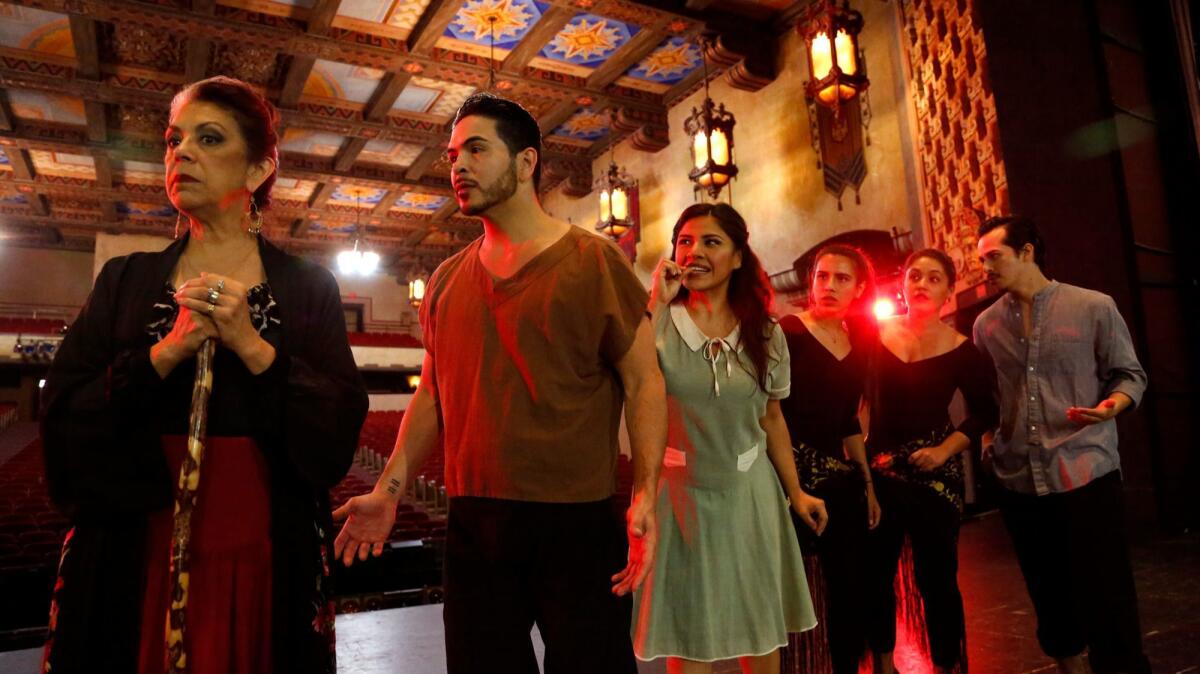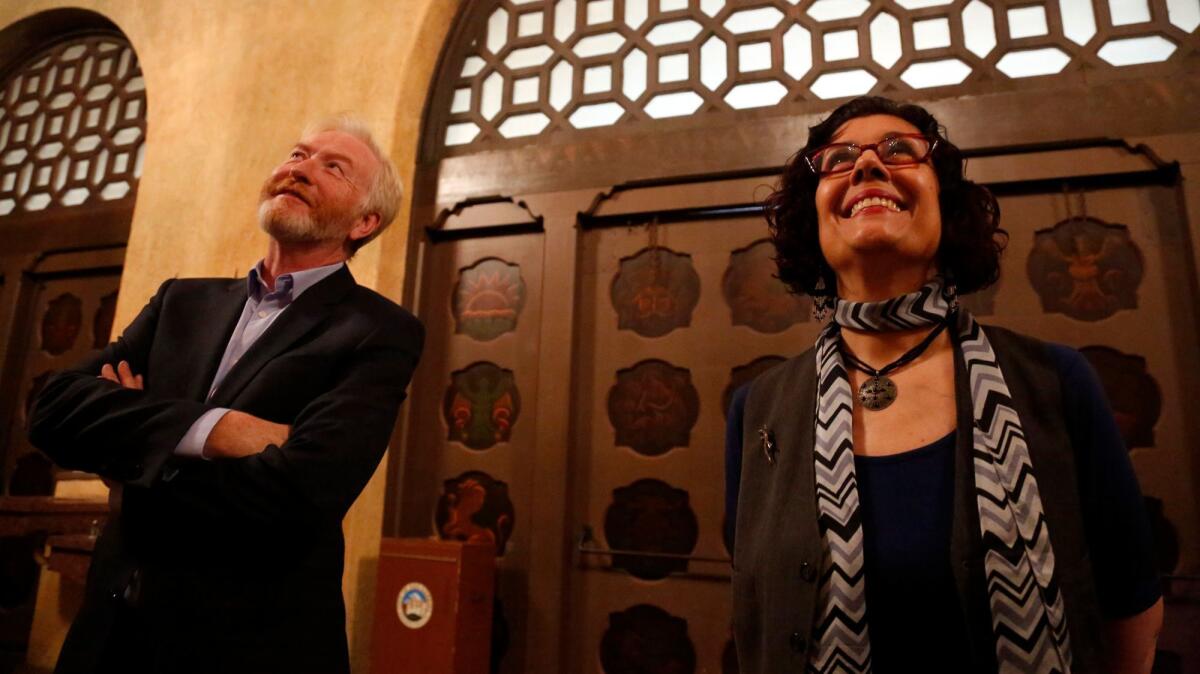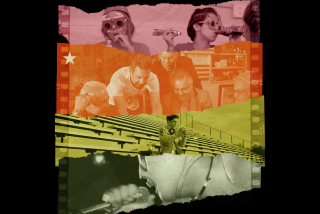‘They Shoot Mexicans, Don’t They?’ leads a monthlong look at Latino representation

- Share via
Just a couple of months after costarring in the hit L.A. revival of “Zoot Suit,” Rose Portillo is reprising the role of another matriarch — leader of the Ramirez family in “They Shoot Mexicans, Don’t They?”
Portillo plays a dance school teacher whose family members are forced to confront their cultural identity in the early 20th century California. One nephew is trying to build a dance career that mixes tradition with his own new creative vision, while a niece dreams of becoming a silent film star like Dolores del Río.
The stage production sits at the center of “The Latin Wave: Exploring Myth, Illusion and Cultural Appropriation,” a monthlong series of events at the San Gabriel Mission Playhouse focusing on Latino representation and exploitation in Hollywood and beyond.
The series kicked off earlier this month with a screening of the 2002 documentary film “The Bronze Screen: 100 Years of the Latino Image in Hollywood,” shown in conjunction with the 1927 Douglas Fairbanks silent film “The Gaucho.”
“The Bronze Screen” covered much ground, including how the low-life greaser and the hot-tempered harlot were the original bad hombre and mujer of Hollywood. These stock characters flickered in and out of 1920s silent films, but they endured in audiences’ imaginations. The film traced the term “greaser” from a time when Mexicans loaded animal hides in California shipyards — work that left greasy tallow smeared on their faces and clothes.
“Hollywood discovered a money-maker,” Luis Valdez, the director and playwright of “Zoot Suit,” says in the documentary. “What more do you need? You got a bad guy. He is dark and dumb, for the most part. He’s violent, a rapist. He can’t speak the language. All of that really works well with the needs of a compact screenplay.”
Jonathan Salisbury, who runs the San Gabriel playhouse’s “Engage” program to make art and artists accessible to the local community, saw the potential to address the lingering effects of those kinds of portrayals.
“I’m really aware of the importance and power of art to humanize us and connect us to each other and inhabit each other’s universes,” Salisbury said.
When About Productions’ artistic director Theresa Chavez proposed remounting “They Shoot Mexicans,” the play she co-wrote with Portillo, he immediately green-lighted the project even though the subject matter spotlights a dark part of the playhouse’s past.

SIGN UP for the free Essential Arts & Culture newsletter »
Chavez blends autobiographical elements of her family history into the set-up of the play. Her uncle owned the Ramirez Dance Studio across the street from the playhouse and was involved in “The Mission Play,” a three-act drama romanticizing the Spanish colonial and Mexican periods of Southern California. The fictionalized plot includes an East Coast filmmaker who spends most of the play raising money to make a silent movie version of “The Mission Play” with the Ramirez family’s choreography.
“Playing the outsider who does exploit and misrepresent, while also trying to find the place where he is sincerely smitten and enamored with the landscape and the people he meets, is usefully complex,” said Peter Howard, who plays the East Coast filmmaker. “You can both love something and damage it at the same time.”
Chavez knew her uncle had danced in multiple versions of “The Mission Play,” but she only recently saw a copy of a 1927 program in which her uncle is listed as playing one of the Native Americans in the text. It frames California’s first wave of Spanish colonizers (especially the mission friars) as the heroes who saved Gabrielino Indians from an uncivilized life.
“It’s from its own time and historically inaccurate,” Chavez said. “It’s painful to look at the language and that this was an acceptable way of speaking. It’s definitely a play written from an Anglo point of view.”
Poet and Los Angeles Times columnist John Steven McGroarty wrote the play in 1912, and it was well received by the public and critics.
“‘The Mission Play’ was the Disneyland of its time. Everyone came to see it over and over,” Chavez said. “If you came from out of town, you went to see ‘The Mission Play.’ Two and a half million people had seen it by the end of the 1920s. It was a phenomenon.”
It joined the storytelling canon of faux L.A. history but was taken as a factual depiction.
The play ran for more than a decade before the San Gabriel Mission Playhouse was built to house the show. Much of the playhouse looks as it did on opening night. The original tapestries and lanterns still hang from the walls and ceiling. Many of the red velvet seats are from the 1920s and 1940s. The painted, wood-carved details and the Mission Revival façade are well preserved.
It’s an ornate set for the site-specific version of “They Shoot Mexicans, Don’t They?” Audience members will move through the playhouse for every scene, and Portillo expects they will see the building in a new way. The Grammy-winning band Quetzal will perform live music composed for the play’s 2005 premiere, with choreography by Francisco Martinez.
Despite the stereotypes they may perpetuate, Portillo can’t help but be intrigued by early Latino representations in film, like the beautiful black-and-white photos of heeled women wearing shawls draped over their heads. In the end, Portillo said, she prefers truth “because the truth includes dreams. And dreams can be fantastical and fanciful.”
♦ ♦ ♦ ♦ ♦ ♦ ♦ ♦ ♦ ♦
‘The Latin Wave’
“They Shoot Mexicans, Don’t They?”: San Gabriel Mission Playhouse, 320 S. Mission Drive, San Gabriel. Preview 8 p.m. Thursday, regular performances 8 p.m. Friday and Saturday, 3 and 7 p.m. Sunday. Tickets are $18 and up. Running time is 1 hour and 30 minutes, no intermission.
Symposium: Grapevine Room at the Adult Recreation Center adjacent to the playhouse. Noon to 2 p.m. Sunday. Free.
Exhibition: Glass Room Gallery, San Gabriel Mission Playhouse. Open 1-7 p.m. Thursday-Sunday. Free.
Information for all events: (626) 308-2868 or missionplayhouse.org
Support coverage of the SoCal arts scene. Share this article.
ALSO
‘Zoot Suit’: How Latino theater born in the farm fields changed L.A. theater forever
These teachers waited in line nearly 24 hours to be first for ‘Hamilton’ L.A. tickets
Robert Schenkkan’s ‘Building the Wall,’ set in Trump’s America
More to Read
The biggest entertainment stories
Get our big stories about Hollywood, film, television, music, arts, culture and more right in your inbox as soon as they publish.
You may occasionally receive promotional content from the Los Angeles Times.











